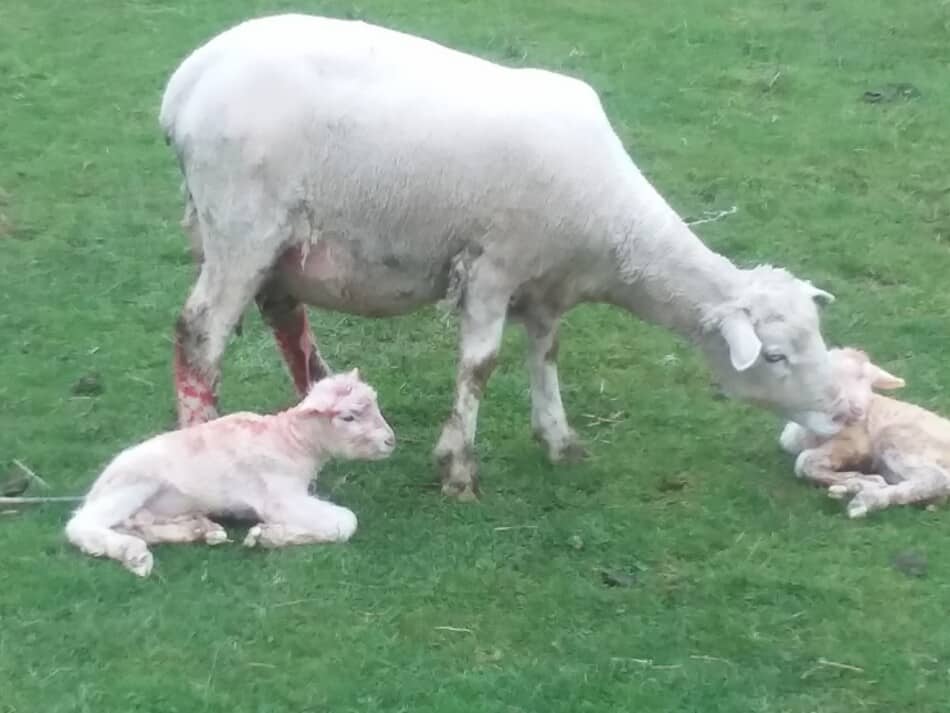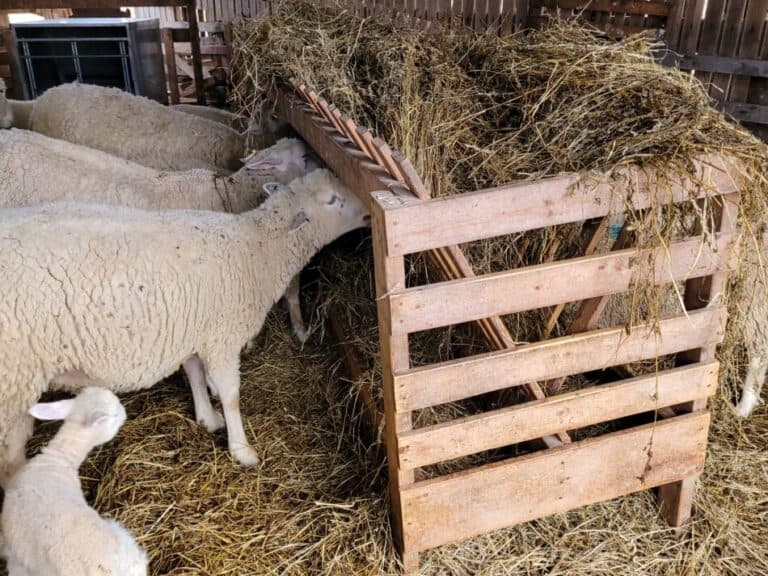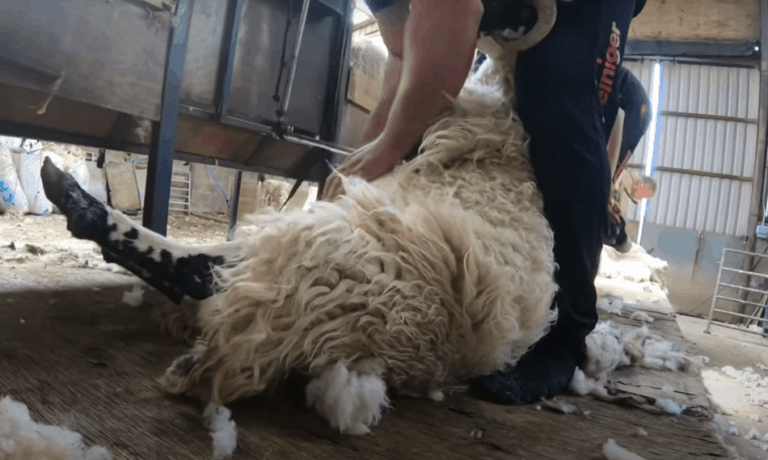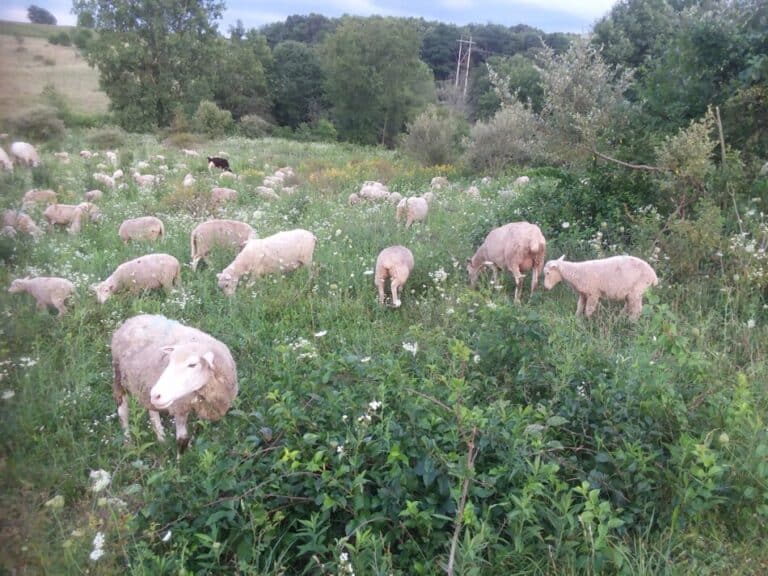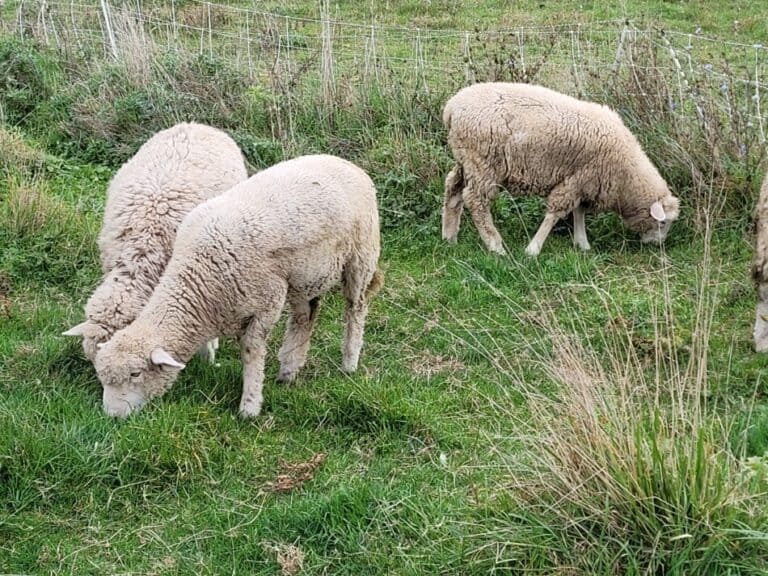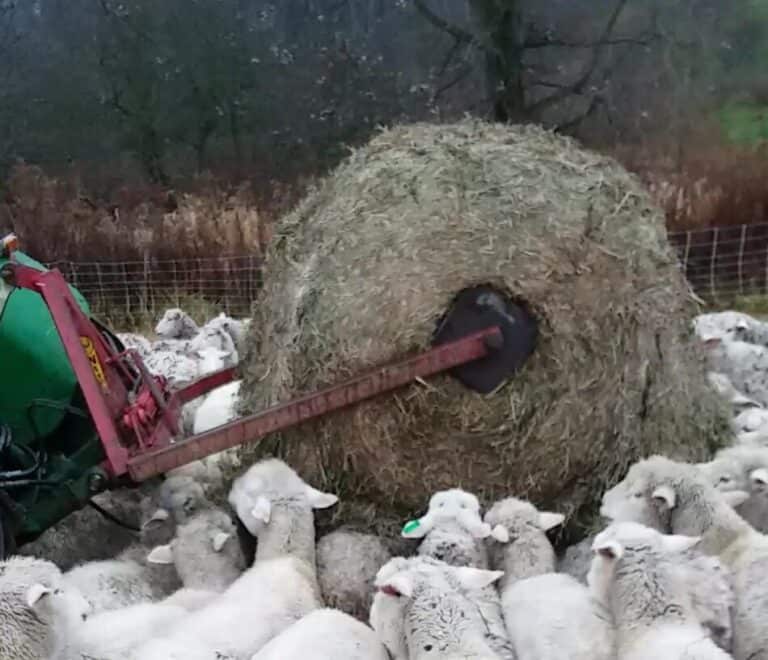How Much Land Do I Need To Raise Sheep?
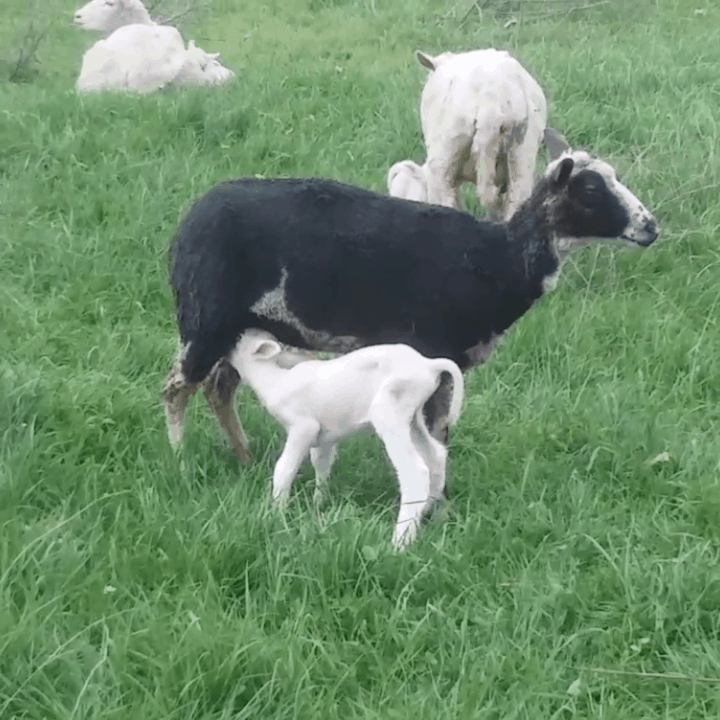
Interested in raising some sheep, but not sure how much land is required for your flock?
Let’s look into some things that will help you decide how to figure this out and get started raising sheep!
The amount of land needed to raise sheep can be an average backyard to as much as multiple acres per sheep, as is the case with range sheep.
As with many aspects of farming and livestock, the number of animals of any sort that you can keep per year varies year to year and place to place.
Some years are very productive and some years not so much.
Small Acreage Or Backyard Sheep is an article I wrote specifically for anyone thinking of grazing or raising sheep on a smaller scale.
Sheep are backyard friendly
The way I always look at the “how much land” question is: do you mow your lawn?
You have enough room for backyard sheep:
- If you use a riding lawnmower
- If you take more than a few swipes with the push mower
- If you have space for a large size dog kennel in your yard, the kind with a chain link fence area
- If your neighbors have goats
- If you have an acre or two (or more)
With backyard sheep, you will need to buy hay when the grass growth does not support the needs of your sheep.
Some people would have hay available all year, others only when the sheep need it.
The rest of the article is more focused on people with a few acres or more of land to work with.
How Many Sheep Do You Need? goes over how to figure up the sheep you can have based on your land.
Forage grown per acre determines number of sheep
Of course, grass growth varies from year to year. An average of the grass production over the past ten years or so will give you a good idea of what to expect.
But where do you get the average of your grass production? You don’t, exactly.
What you do have is the average for hay production for the year for your area and hopefully for your farm specifically.

Use hay yield numbers to calculate forage for sheep
Use the average hay yields for your area to figure up the amount of grass that your land is likely to grow.
All grasses are not necessarily hay grasses (some species of grass that are good for the animals to graze are not the best for hay), but it is a good place to start.
An example of this is bluegrass, it’s just too short for hay but it grows well throughout the year and our sheep love it.
Find the hay yields from your area to start to figure this out.
Be sure to compare grass to grass
Be sure you are looking at the same, or close to it, species of grass as you have in your pasture.
Do not compare to an annual or alfalfa, that will give you misleading numbers. Compare to a perennial grass.
It is common to grow plants other than pasture plants for hay to get higher yields from that acreage, for example by planting oats and peas or using corn for silage.
These annuals (plants that only live one year) will grow like crazy but not come back next year.
Of course, you can plant annuals for your sheep, as well. They are great for out of the normal growing season sheep forage. Just don’t use the annual numbers to compare with.
Using the wrong numbers will give you inaccurate results for your sheep if you accidentally use these figures instead.
Determine sheep per acre for your area
Let’s do a few examples of the math to figure all of this out and give you a good idea of how to determine the sheep you can raise.
If your hay production is a total of three tons per acre per year then you will have 3 tons x 2,000 pounds in a ton=6,000 pounds of hay per acre.
Next, we figure up the sheep days per acre. That is the amount of sheep your acre can feed for one day.
If your sheep are eating 4 pounds of hay per day per sheep that 6,000 pounds of hay per acre will feed 1,500 sheep for one day. (6,000 divided by 4=1,500)
That’s 1,500 sheep days. I know this “sheep days” thing is a bit odd, stick with me here. It will all come together shortly.
Since you will be feeding your sheep for more than one day, we need to reduce this number down to the days in your normal growing season.
The growing season is the time when the grass or other forages have available to replenish themselves in a year.
The growing season is how long you could expect to be able to keep sheep out on growing grass.
So take the 1,500 sheep days and divide by the days in your growing season.
Here our growing season is 180 days so take 1,500 sheep days divided by 180=8.3.
You ended up with 8.3. 8.3 what? 8.3 sheep can be fed off of that acre for the year using these numbers.
Do the same type of math for your area to get sheep days, then sheep per acre for you.
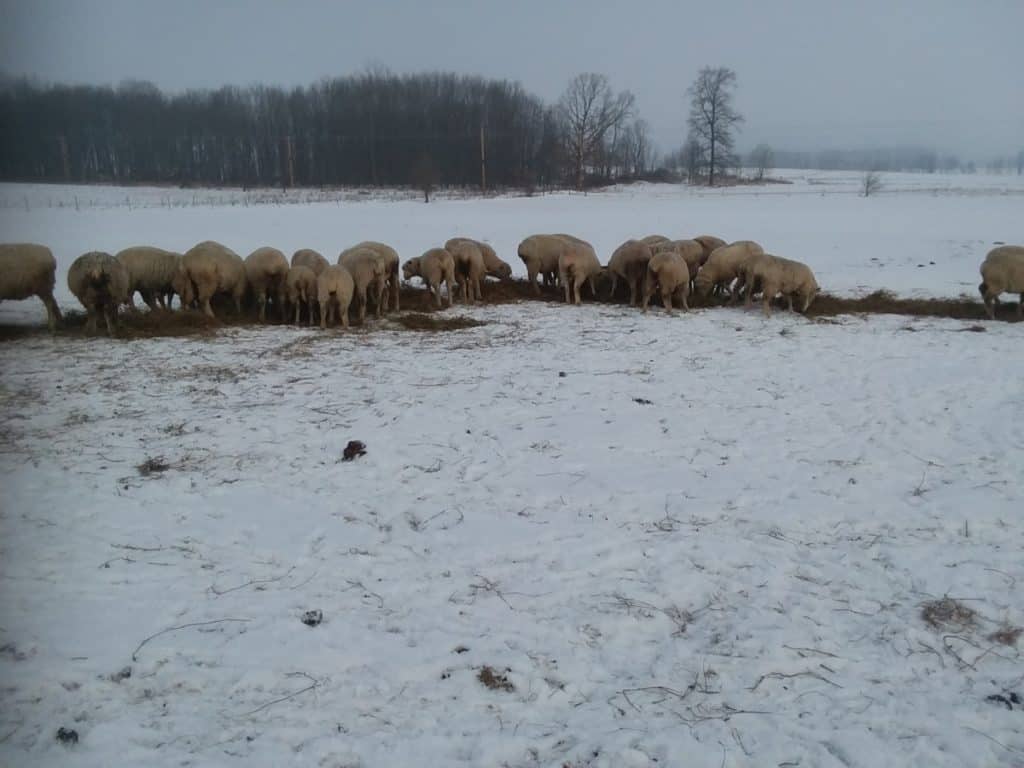
Sheep need to eat all year, that means hay
While feeding hay is not mandatory, most folks do not have the grass to feed their flock year round, so use hay or other forages to fill that gap.
Choose High Quality Hay gives you a checklist of things to go over the next time you are buying hay for your flock.
It is important to remember that a year is 365 days long and your sheep will definitely want to eat all of those days, but you just figured out summer forage production and eating.
This means you will also need to consider that for the other part of the year (the non growing season) your animals will need to eat stored feed like hay.
If you are fortunate enough to live in an area where there is a high likelihood of grazing the full year adjust your numbers to divide total forage production by 365 days as opposed to the 180 I used above.
Forage yields can and will vary
If you are newer to livestock and farming in general you may not be aware of the variability of grass or any other forage growth in a given year.
All of the numbers you will be able to get to use as a basis for your calculations are based on averages. This is not reality. No year is ever average.
Then what good is all this math? You have to start somewhere.
A good guess is better than a total lack of planning, even when you have to adjust the plan as you go through the year.
Sheep can eat more than grass
Good news, there are many options of how to take care of your sheep and your land.
You may have more grass than you need
If you are one of the lucky ones you did the math and now you know you will likely have more grass than your sheep will need. This is great!
You can choose to have the sheep just graze over the whole area and then mow once in a while to keep the weeds down, easy but wasteful.
A better way that will get you more use out of your land year round is to divide off at least some of your pasture and keep the sheep completely out of it.
This can grow to be used as hay or kept for winter pasture.
If you are unfamiliar with sheep being outside in the winter, you will be surprised at how much grass they will eat.
Even if they need to dig through some snow as long as they have shelter from the wind.
Your sheep numbers match grass grown
If your sheep numbers came out right on or you will be purchasing the number sheep to fit your pasture, you also have a few options.
Just letting the sheep have access to the whole pasture is the easiest (but most wasteful) way to graze animals. This is called set stocking.
Set stocking your pasture is easy but wasteful
Unfortunately, set stocking is not the best use of your land as far as pasture and soil health are concerned.
In set stocking animals will continually eat down the regrowth of the plants they like and ignore the plants they don’t like as much.
The pasture will start to look patchy with really short spots and tall unused spots.
This is not getting the best use out of your land and wasting some of your productive ability that you will need to make up for by buying more hay.
Divide the sheep pasture into sections
To get the most out of your land you need to separate off the pasture the sheep have access to. They have a small section at a time, then move them to another section to let the first area you grazed regenerate.
Even dividing your acreage in three or four sections will increase grass production and save you hay money later in the year, since the sheep will have more to eat before they need hay.
Consider rotational grazing for your pasture
The best use of your land is to use a rotational or grazing plan.
This means giving the animals a small section of grass every day or every few days then moving them completely off of that grazed area to new grass.
Keep moving the sheep around in sections until the first section is regrown enough to put the sheep in it again for a second round of grazing.
Use electric fence to section off sheep grazing
Rotational grazing is usually done with electric fencing since electric is portable and quick to set up.
Rotational grazing will get you the most grass growth from your pasture for the year.
You may have more sheep eating than grass
On to those who did the numbers and found out you will have more eaters than grass.
You still have some options but less room for errors unless you are willing to sell down to the number of sheep you can more easily keep on your land.
If you are keeping the flock size as is then the best use of your land by far is rotational grazing.
Moving the sheep to a new section of pasture daily while keeping them off of what they just grazed will get you the most production from your land.
Set stocking with too many sheep will kill the grass
If you decide to just set stock (not rotate at all) the sheep will eat everything down then continue to nip off the regrowth which will weaken the plants.
This will eventually cause the current plants to die off and be replaced by weeds that can handle this type of management or by nothing, your pasture will just be dirt because of the abuse the area continually takes.
The pasture needs rest periods to regrow! Plants want to regrow as soon as they are eaten off.
If the land is compacted or continually grazed the plants you want to grow in the field will die off. The forages will be replaced by weeds that can handle the grazing/pasture management situation.
Plan to feed a lot of hay to your sheep
Plan on plenty of hay feeding to give your sheep enough to eat since you are short on pasture area.
If you keep the sheep on the pasture at appropriate times then keep them off until the grass regrows you will have at least some pasture for them.
Consider reading my article Do Sheep Ruin Pastures if you are looking for more information regarding having more sheep than carrying capacity of your pasture.
Feeding The Flock is a nice, easy to read article from Penn State Extension going over the feed needs of your sheep.
Related Questions
Do sheep destroy pastures?
No animal, sheep or any other, will destroy pastures on their own, only poor management destroys pastures.
Can sheep and cattle be kept together?
Sheep and cattle can be on the same pasture together. Sheep and cattle together will need different fencing than is you just had only cattle.
